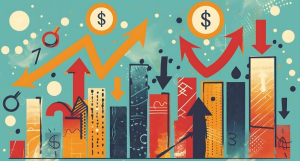The fluctuations in interest rates significantly impact the U.S. domestic economy. Understanding how these rates shape various economic factors helps residents, businesses, and policymakers make informed decisions. As interest rates rise and fall, they can either stimulate or stifle economic activity, affecting everything from housing markets to employment levels.
This article delves into how shifts in borrowing costs influence consumer spending, corporate investments, and overall economic growth in the United States. By exploring these dynamics, we gain insight into the broader implications of monetary policy on the everyday lives of Americans.
Impact on consumer spending

Interest rates play a crucial role in determining consumer spending. When borrowing costs are low, consumers are more likely to take out loans for significant purchases, such as homes and cars. Conversely, higher costs can deter consumers from spending, leading to a decrease in overall consumption.
For instance, lower rates make mortgages more affordable, which typically results in increased demand for housing. This rise in demand often causes home prices to go up, benefiting sellers and real estate agents. However, if the Federal Reserve raises borrowing costs, it becomes more expensive to borrow money, reducing the number of people able to afford new loans.
Moreover, changes in interest rates can also affect credit card debt. Lower borrowing costs reduce the interest payable on outstanding credit card balances, prompting individuals to spend more freely. On the flip side, higher rates can lead to increased monthly payments, thus reducing disposable income and, subsequently, spending.
Influence on saving behavior
The rate at which financial institutions lend money can significantly influence saving habits. Lower borrowing costs often discourage saving because of the reduced returns on savings accounts and other fixed-income investments. Consumers might prefer to spend or invest in higher-yielding assets instead. On the other hand, higher borrowing costs offer better returns on savings, making these accounts more attractive.
This can lead to an increase in the national saving rate. Higher savings can subsequently provide banks with more capital to lend, though this cycle is often balanced cautiously by the Federal Reserve to prevent economic overheating. Therefore, understanding these dynamics offers a clearer picture of how changes in rates affect both spending and saving within the economy.
Effects on consumer confidence
Fluctuations in interest rates can also impact consumer confidence. When borrowing costs are low, consumers may feel optimistic about their financial situation, leading to higher spending and investment activities. This optimism often translates into a more robust domestic economy. However, rising borrowing costs can create a sense of caution among consumers.
Fear of higher debt repayments and economic uncertainty may lead to reduced spending and a slowdown in economic growth. Monitoring consumer confidence is essential as it can provide early signals about the direction of the domestic economy. Policymakers often closely track these sentiments to adjust their economic strategies accordingly.
Influence on corporate investments
Companies heavily depend on interest rates to make critical investment decisions. Lower borrowing costs make it cheaper for businesses to finance expansions, purchase new equipment, and hire additional staff. These investments contribute to economic growth and job creation. When rates are favorable, firms are more inclined to invest in projects that might have otherwise been deemed too expensive.
This increased activity can boost productivity and contribute to a more vibrant economy. However, higher borrowing costs can deter companies from taking on new projects. Increased costs of financing can lead to delays or cancellations of planned expansions, stifling growth and potentially leading to layoffs.
Impact on small businesses
Interest rates have a pronounced effect on small businesses, which often rely heavily on loans for their capital needs. Lower borrowing costs make it easier for these enterprises to obtain credit, enabling them to grow and innovate. Small businesses are particularly sensitive to changes in borrowing costs because they typically have less access to alternative financing sources compared to large corporations.
Favorable rates can lead to increased entrepreneurial activity, which is critical for economic diversity and resilience. Conversely, higher borrowing costs can pose significant challenges for small businesses. Increased debt service can strain their finances, leading to decreased investments in growth and innovation. This can, in turn, slow down the broader economy, given the crucial role small businesses play.
Influence on stock market performance
The rate at which money can be borrowed also impacts stock market performance. Lower borrowing costs generally lead to higher stock prices as investors seek better returns, shifting their focus from bonds to stocks. Favorable rates can encourage companies to invest more in growth initiatives, boosting their stock values. Investors gain confidence in the market’s performance, often resulting in a bullish trend.
However, when borrowing costs rise, the stock market can suffer. Higher rates mean higher costs for companies to borrow money, which can result in lowered profit margins and stock prices. Investors might redirect their funds to less risky, fixed-income assets, leading to a bearish market trend.
